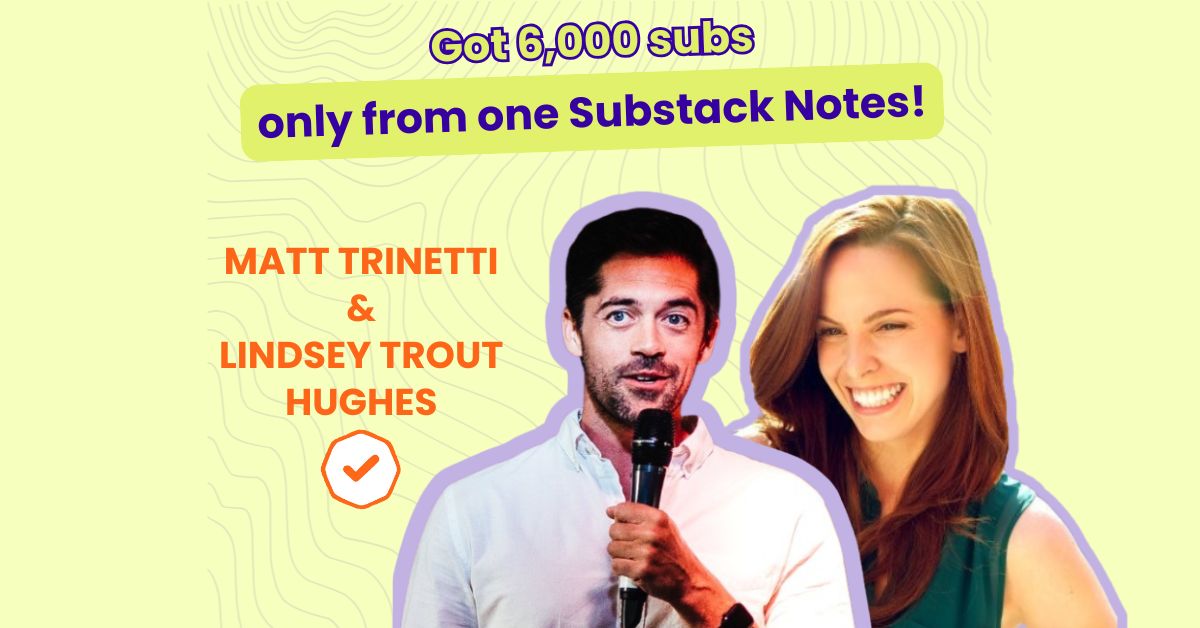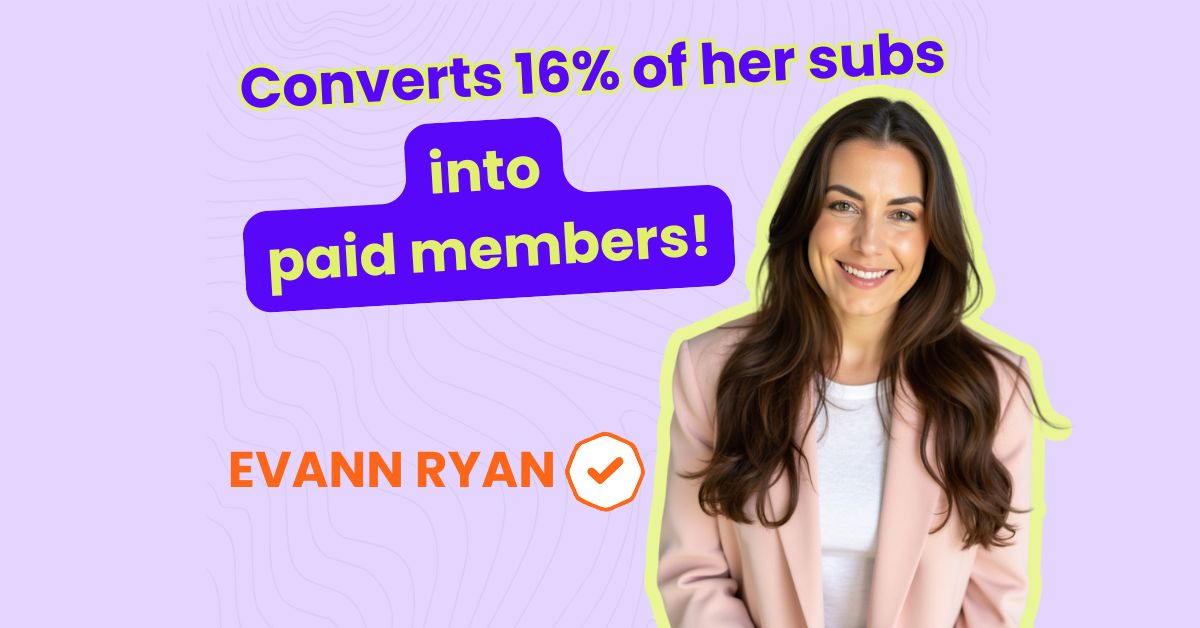Interview Date: April 13, 2025
Table of Content
- Meet Kat River
- Newsletter Identity Card
- Tools she uses to run her newsletter
- How she started her newsletter
- How she grew over 4,600 subcribers
- His paid subscription strategies to become a Substack bestseller
- Personal & professional impact of running a newsletter
MEET THE CREATOR
Kat River is a writer, poet, and mother of two, living a slow, intentional life. Alongside her husband, a relationship coach, Kat balances parenting and creative work while supporting other mothers in building intuitive, family-centered businesses.
In 2022, Kat launched The Mother Makers, a Substack publication that quickly became a thriving space for mothers wanting to grow their businesses without getting into the hustle culture
What started as a community became a Substack Bestseller with over 4,600 engaged subscribers and over 160 paying members currently.
At its peak, Kat had over 270 paying members—impressive for someone who’s built a business rooted in slowness, care, and aligned growth.
Even more remarkable, after taking a 9-month break from publishing, she returned to find herself still a Substack Bestseller—despite losing over 100 paid subscribers during that time!
In this interview, Kat shares:
- How she grew her Substack from 0 to 4,600+ subscribers, with 80% coming organically from within Substack
- How she used Instagram creatively to drive early subscriber growth
- Her journey to becoming a Bestseller with over 270 paying members
- How she managed to keep her Substack bestseller status after a 9-month break
- How her newsletter has impacted her identity as a writer and creator
Enjoy!
NEWSLETTER IDENTITY CARD
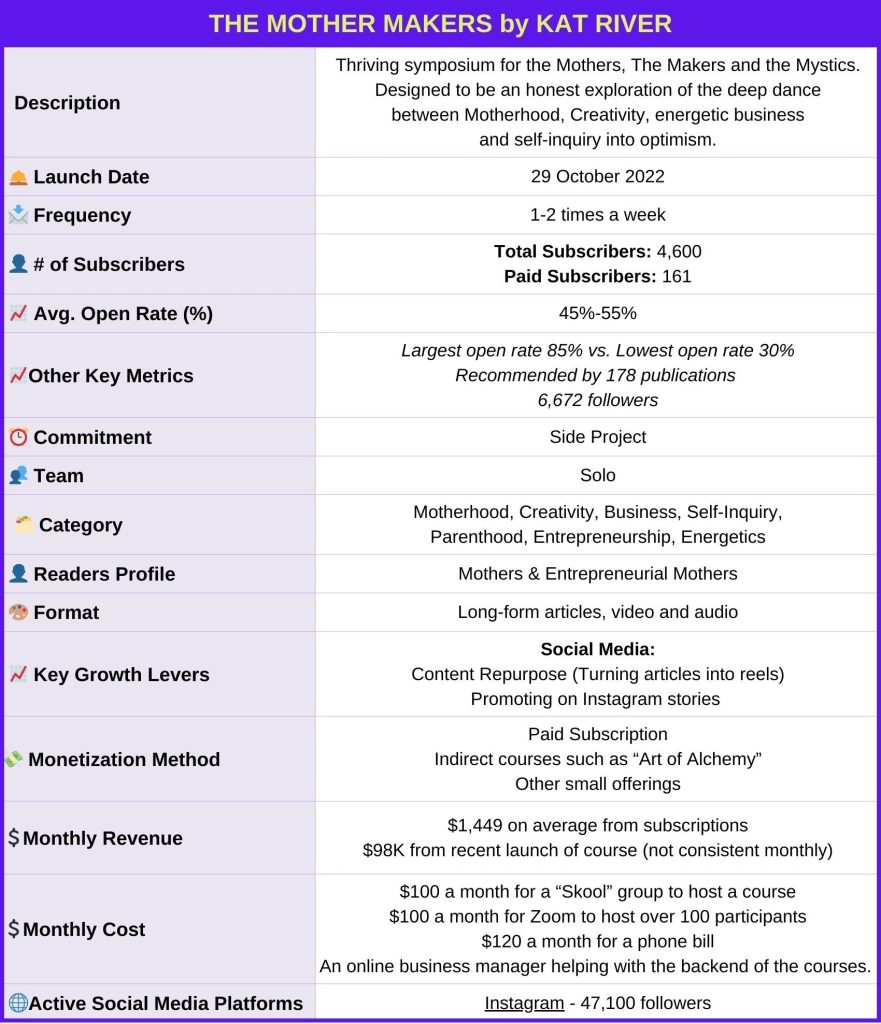
TOOL STACK
- ESP: Substack
- Design of visuals design: Canva, Pinterest
- Webinars: Zoom
- Digital Products: Skool, Zoom
- Affiliate: PayPal
- Payments: Stripe
START
How and why did you start The Mother Makers in the first place?
I started The Mother Makers firstly as a community. I believe that mothers who are following an entrepreneurial path but do not want to continue down the route of hustle culture or girlboss ideals are desperately looking for another way.
A way where our children and family unit are nourished. Nervous systems are supported. Where we can be creative and stay connected to intuition while also bringing an idea to life and often generating resources for our families. It’s a unique pathway.
Typically, as mothers in the entrepreneurial space, we have different challenges. Our focus is split between family and work, but at the same time, we cannot take advice from business coaches who don’t have children. If we want to live cyclically, attuned to our bodies, avoid burnout, prioritise peace, and connect intuitively, then we need to find another way.
That’s where Mother Maker was born. It morphed into an online program and community that was incredibly well received and, more recently, is the reason for a Substack rebrand and for curating my publication into a social hub for the mother makers to support them in bringing their vision to life.
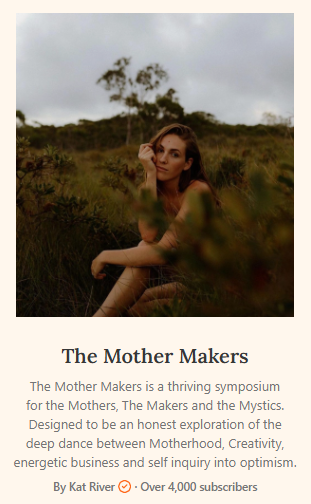
GROWTH
Which strategies did you use to grow over 4,600 subscribers?
0 – 100 Subscribers
This was Instagram, I cross-promoted as much as I could. It was also before the word “Substack” would get flagged there.
I had quite a loyal and invested audience there – though I was determined to move across to Substack as my main home online due to the ever-changing and unpredictable algorithm there.
I was planning on getting off Instagram for about 3 months, as I wanted to conceive my son and was craving quiet. I told everyone I would document the BTS on Substack and to join me there if they wanted to remain in the loop.
100 – 1,000 Subscribers
It took time to bring people across, but I would say that my first 700 subscribers were people who already knew me, and then the tables began to turn, and my publication began to grow through the Substack networks.
This is a pivotal moment because now, 80%+ of my audience comes from Substack organically and barely any from Instagram.
I love that it’s so possible to grow on Substack.
I focused on getting amongst communities. I didn’t understand Notes at the time as it was a new Substack feature, but I’d go and comment and respond to others on other publications and make friends.
I would prioritize “recommending” them officially and also speak their names in rooms of opportunity, like when Substack would make a thread for shoutouts, etc. This led to others recommending me, too.
1,000 – 3,000 Subscribers
During this period, I had some big life events happen such as falling pregnant, documenting pregnancy, and also birthing my second son. These topics seemed very well received by my audience, and I was growing fast.
I also made an “intro to Substack” video class for my Instagram audience to help educate them. I was going all in on Substack at this point, scheduling a post every Wednesday and Sunday.
I had an interview series called “Sundays are for mothers”, which would be shared and circulated, and I offered what’s called “Mother Maker Cauldron”, which was a collection of recommendations, women who inspired me, podcasts I had listened to, etc over the month.
I would actively shout out other publications I loved and had read. This would be circulated through their networks, too.
3,000+ Subscribers
3,000 – 4,000 happened by accident. I think this is somewhat hilarious, but I guess with Substack, it’s the first 100, the first 1000, that is a slow burn. Then, it quickly gathers momentum.
I took about 9 months off Substack, and during that time grew 1,000 subscribers without publishing. All because of the connections and relationships I had built in my early days. There is no other platform that this would happen on!
At this point, I have 178 people recommending my publication and have had 1644 people find me through those recommendations. This is phenomenal and one of the key features of Substack that I love. Word of mouth. I believe this has been key.
I post on Notes usually twice a day with stories, thoughts, or value adds. I comment and network on other people’s posts. I took the pressure off publishing twice a week and am currently publishing once a week and enjoying this pace.
You have over 47k followers on Instagram, and in one of your Notes, you mentioned your audience came from Instagram in the early days. (see here) What were your most effective strategies to turn your Instagram followers into newsletter subscribers?
I believe it’s important to cross-promote. What I found is that people on Instagram already feel overwhelmed with the thought of another app.
Sure, you can say, “Hey, come read my newsletter”, but unless it’s really value giving to an audience, it’s a big effort and ask to request they jump across. I feel like it’s part of my responsibility to help educate and paint a picture of what Substack is like.
I explain Substack as a big library where you can settle in on a velvet couch and a cup of chai in the morning sun and read from writers all over the world on the topics you’re interested in. You can subscribe to multiple newsletters and have a curated space that honors long-form writing and rewiring the brain to slow down. I explain that they can opt in, like an email newsletter, or they can indulge in the app. That it’s designed to quieten the noise of social media rather than add to it.
I take screenshots from parts of my articles and add them to my stories, especially parts that spark curiosity but lack a bit of context to give incentive to come across and read more.
I also take the theme of my edgier posts/articles and create reels about them that are to the point but done in creative ways. I then say that people can comment a keyword below and that I would get them the article.
I avoid saying “link” or “substack” and often refer to Substack as “Subby” or “my newsletter”, as Instagram is quick to limit reach the second you’re directing people off their platform. We have to find creative ways to play this game.
You cannot use Substack and Instagram in the same way. Instagram relies on visual journeys for people, shorter content, with hooks and “to the point” discussions.
Being a little controversial can be helpful as it’s such a fast-paced platform; you do need to be able to grab attention. This can absolutely be done with good intentions and soulfulness.
Substack is a more intellectual space, so the invitation has to be to slow down and foster connection. We set the culture of the space, and it’s our job to educate others so it’s less overwhelming when they arrive. This will really help retention rates and also inspire others in your communities to write and create on Substack too.

MONETIZATION
You had over 270 paid subscribers at your peak while writing full-time on Substack. After taking a year off, you’ve returned with 161 paying members and are ready to continue.
How long did it take for you to become a Bestseller in the first place before you took a break?
Ok, this is important to discuss because in a “growth” culture, it is often assumed that success equals a consistent increase in money or numbers.
Even though I dropped from 270 to 161, I believe that is still success. Mainly because the time I took off was to recharge and nourish other areas of my life. This is sustainable growth, and when we zoom out over a 10-year period, it will be a tiny blip in a larger vision.
When we look at mother-centric business, it’s important to create lifestyles that support our slow seasons and the seasons of momentum. It’s also crucial that we don’t judge these seasons.
Life happens. That’s normal, and I’m not interested in a business life that requires me to abandon the needs of my family in the name of consistency and linear growth.
In saying that, I’m really excited to be back and keep providing value for my community, as I know that if I continue to create moving pieces that help women think differently and feel connected to hope and sustainable expansion, the byproduct is that my community will continue to grow.
I began Substack in October 2022 and was incredibly inconsistent. I would post once a week or biweekly. Sometimes a month later. I would write a lot of “Musings” and personal insights that were not always relevant to others.
My audience fluctuated a lot. It would grow and come down and grow and come down. I didn’t mind. I enjoyed the journey.
I realised that when I became consistent, my audience grew a lot more consistently, too, due to being able to rely on my posts. I would schedule my articles to come out each Wednesday, and I also had an interview series for the mother makers called “Sundays are for mothers”, which came out bi-weekly.
I also shifted from focusing on my free subscribers to nurturing and nourishing my paying audience. That felt uncomfortable at first because I had significantly more free subscribers, but I realised if I didn’t start writing for my paying community, nobody would pay!
At the beginning of May 2023, I had 50 paying subscribers. The following month, at the beginning of June, I received a “Substack bestseller badge”. That meant I had hit 100 paying subscribers. I had no idea that was a thing; I just got the email and was confused at first. To me, it was less of a status symbol and more of an acknowledgement for building and nurturing a community.
It was a slow build to 100 paying subscribers, but then momentum began to hit, and by September 2023, I had 222 paying subscribers. In November 2023, it reached its peak at 278.
When did you launch your paid subscription and how did you decide that it was the right time for you to activate it?
I wrote about 6 free posts over a range of topics I was interested in when I first began. I knew I wanted to give people an option to pay, but I wasn’t attached to “Launching” a product, if that makes sense. After the free topics, I made one for paying subscribers.
I think it brought me three people as the first of my paying community and two more on a week-long trial. I was elated. My only goal when starting Substack was to have my weekly coffee at a cafe and two hours of writing time covered.
I didn’t get into my head about “when” to launch paid. I was staying curious and experimenting. I didn’t even know if people would want to pay for what I had written.
How did you manage the relaunch process when you returned to Substack? What did you do best to maintain your bestseller status after your break?
I relaunched paying subscribers at the end of February 2025 after pausing them around May 2024.
I still posted during that time VERY occasionally for free community. Then I posted more as I did a lead-up to reactivating paying subs.
I never once thought about maintaining bestseller status when taking a break, but I did pause all my paying subscriptions after a few months when I realised I wouldn’t be back writing anytime soon.
Pausing subscriptions for some may seem like a bad idea for some, and I do want to encourage an audience who is at peace with writers’ creative fluctuations, but I also knew that for some of my audience, $9 a month was a big stretch, especially for a newsletter.
If I wasn’t providing the service promised, I wanted to make sure I honoured my community by not expecting them to pay.
When I returned, I published about 13 posts for free (Not weekly, I did a few a week) before I reestablished paying subscribers. I did this because my audience grew by 1,000 subscribers even when I wasn’t active for about 9 months.
I needed to give these new friends a taste of what I was about. Then, I gave everyone a post that invited them to unsubscribe or to stay connected to the community before I reactivated subscriptions.
What are your strategies to convert free subscribers into paid ones or gain new paid subscribers? Among various strategies you’ve tried so far, which ones work best to grow your paid subscriber list?
One thing I believe is important is writing a short “Intro” at the beginning of each post that explains what the article/post is about. Many people don’t want to read to the end to get the “point” of the article. This immediately filters out those who may not be interested in the topic and those who are.
Then, I always invite people to upgrade. I explain what it is they pay for when they upgrade. I break it down into “just over a coffee” because many people don’t click through because they assume a subscription could be $30—especially if they aren’t familiar with Substack.
I also do my best to weave my personality and stories through my articles. If there are two writers writing about the same topics, why would they subscribe to one and not the other?
Normally, people subscribe to who they feel most connected to, and the only way to have an audience feel connected to you is by revealing your values so that your audience can see themselves in you.
How did you decide what to offer differently to paid subscribers to make it compelling for them to join as paid members?
I write an article for free monthly, and I do my best to make this highly valuable and somewhat shareable.
I want this to go far and wide.
My paying audience gets access to a lot more intimate and personal discussions. Behind the scenes and high-value stories. Usually, my paying subscribers have access to more triggering conversations that I don’t want to have with the whole internet. I see it like an inner circle, a community with whom I would sit down and have a coffee in a sunroom cafe filled with plants. Our conversations reflect that.
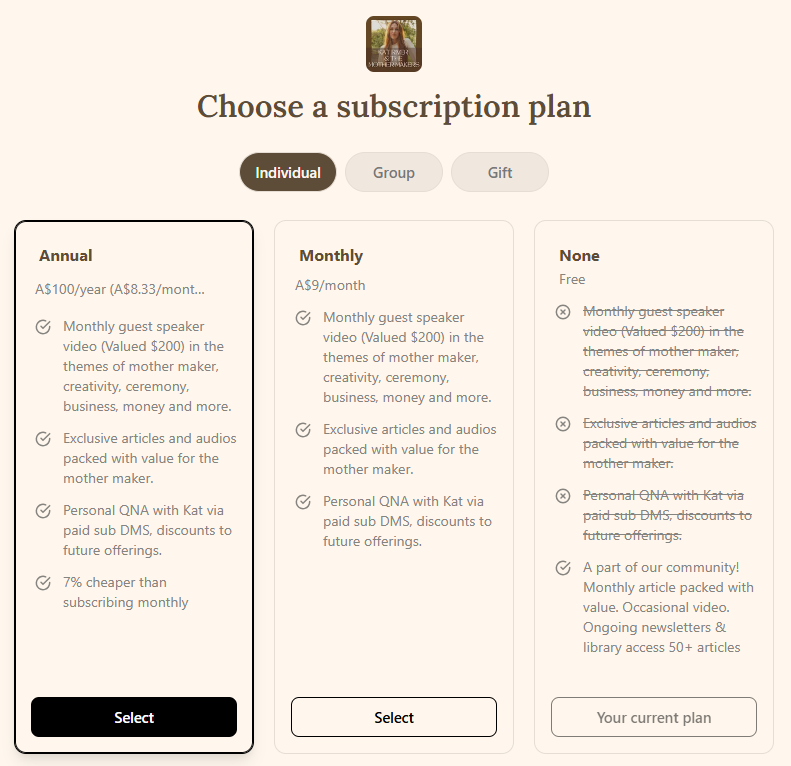
What are the biggest lessons you’ve learned from running a successful paid subscription?
1. People have so much noise in the online space. They are already generally overwhelmed. The ability to simplify is powerful. Simplify our messages, refine our writing, simplify our community, and what we want to offer.
2. Educate people on the platform. If you want to have your community reading from email to Substack, you need to show them why it’s worth joining the app rather than opening it in their inbox. Help them see the value of the space.
3. There is a lot of conflicting advice when it comes to “writing for a community” or “writing for yourself”. It’s a mix. Write on topics that serve your community and their needs, but write it in a way that feels inspiring and interesting for you. There’s a fine line between doing what you want on Substack and then actively pursuing some growth on Substack.
Many want growth but then don’t do anything other than write. Unfortunately, we do need to be a little uncomfortable and put ourselves out there to build relationships. Otherwise, we could alternatively write in our journals on our bedside table instead. Learning to market yourself is a skill. It can be done soulfully. It can be done while aligned with your values and maintaining your voice.
Beyond paid subscriptions, you also monetize through channels like courses and smaller offerings. Could you share more about how you effectively promote and upsell these products through your newsletter?
I have had online courses in the past that are very relevant to my community. If I’m promoting those, I’ll do so in my free newsletters. I don’t like to gatekeep and do believe in being generous with the information I give, though sometimes the deep dives have to be in more private spaces to be received in the ways I hope.
I have more control over private spaces and can curate the sort of environment I believe is helpful for others. I like to give, though, and I give a lot of high-value conversations, videos, and topics for free. This helps those who may have just found me to know pretty quickly if my work resonates with them or not. I also want people to feel like they are welcomed and appreciated, no matter if they are a part of my free or paying community. Those who pay more simply get more access, proximity, and intimacy.
My courses and smaller offerings are actually the main aspect of my income, but I see huge value in shifting away from mainstream social media and onto a platform such as Substack because it’s a direct line of communication with those who have opted in to hear from you.
IMPACT & LEARNINGS
How did building The Mother Makers newsletter contribute to your life professionally and personally?
My Substack publication began to shift my beliefs around being paid as a writer/artist. I just never really thought it would be for me and that I’d only make money through business elsewhere. It was liberating to feel like I could make a platform like this work. It showed me how many people are eager to support writers and creatives.
The process of embracing the identity of “a writer” softened me and made my inner child happy. Not because the profession is childlike, but because it feels pure to follow a path of curiosity my 11-year-old self dreamt of.
I could also see how the platform could work for other friends in their industries, even if they weren’t predominantly writers, including my husband. It’s been fun to have a group of us leaning into the Substack space.
What would you do differently if you had a chance to start over The Mother Makers?
I would begin as The Mother Makers from day one. I originally started under my stage name, Kat River, and I named my publication that too as I didn’t understand how the publication was separate from me as an author. I began with a lot of musings, and my message was possibly too personal and wishy-washy.
Now, I have a clearer overall message and use storytelling that is more relevant to the point I’m trying to make in each article.
I also would have started on a consistent schedule from day one. Instead of publishing a lot then not at all for a while, I’d write a lot while in a creative surge and pre-schedule it all weeks in advance, especially around my cycle and bleeds. That way, I could create consistency without actually having to be consistent in the moments I’d need rest.
I would lean on collaborations with similar writers early on, guest write for others, and find ways to co-write posts together.
Lastly, I’d get into the dashboard and Substack back end way earlier. I’d have my welcome emails sorted and all of the finer details worked through. When I did this about 9 months into my Substack journey, I realised it helped me take my experience on Substack more seriously and honour my time here more.
What would it be if you had the right to give one piece of advice to aspiring newsletter creators?
Network and community building are your superpowers. People want to be received by their work, but they are often not willing to put themselves out there.
Building genuine relationships is 10x more powerful and impactful than trying to restack your post to Notes and hope for the best.
Find writers who are writing on similar topics to you (Through the Substack categories or go down little wormholes until you find people you like), and get amongst their communities.
Comment on things with meaningful thoughts, get back to other people’s comments, and show up regularly. This not only has others find you but has you feeling more emotionally invested in the space beyond your own publication.
Speak other writers’ names in rooms of opportunity/recommend them on your Substack and share their names with others and watch as the generosity becomes reciprocated.
This is how you build here sustainably.
The second would be to master your craft and become a better writer. Edit, edit again, simplify your message, fluff it up here and there, and enjoy the process of refining your skills.
3 Popular The Mother Makers Issues
- Ways we reject “the village” (we say we want)
- The Shadows of Substack (and other platforms)
- World-crafting for business
Where to find Kat River
- “The Mother Makers” Newsletter

